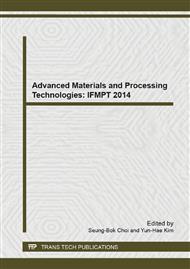[1]
KIM D J, SEOK C S, KOO J M, et al. Fatigue life assessment for brake disc of railway vehicle [J]. Fatigue & Fracture of Engineering Materials & Structures, 2010, 33(1): 37-42.
DOI: 10.1111/j.1460-2695.2009.01412.x
Google Scholar
[2]
Zhu Z, Peng Y, Shi Z, et al. Three-dimensional transient temperature field of brake shoe during hoist's emergency braking [J]. Applied Thermal Engineering, 2009, 29(5): 932-937.
DOI: 10.1016/j.applthermaleng.2008.04.022
Google Scholar
[3]
Milošević M S, Stamenković D S, Milojević A P, et al. Modeling thermal effects in braking systems of railway vehicles[J]. Thermal Science, 2012, 16(suppl. 2): 515-526.
DOI: 10.2298/tsci120503188m
Google Scholar
[4]
Gao C H, Lin X Z. Transient temperature field analysis of a brake in a non-axisymmetric three-dimensional model [J]. Journal of Materials Processing Technology, 2002, 129(1): 513-517.
DOI: 10.1016/s0924-0136(02)00622-2
Google Scholar
[5]
Talati F, Jalalifar S. Analysis of heat conduction in a disk brake system [J]. Heat and mass transfer, 2009, 45(8): 1047-1059.
DOI: 10.1007/s00231-009-0476-y
Google Scholar
[6]
Talati, Faramarz, and Salman Jalalifar. Analysis of heat conduction in a disk brake system., Heat and mass transfer 45. 8 (2009): 1047-1059.
DOI: 10.1007/s00231-009-0476-y
Google Scholar
[7]
Naji M, Al-Nimr M. Dynamic thermal behavior of a brake system [J]. International communications in heat and mass transfer, 2001, 28(6): 835-845.
DOI: 10.1016/s0735-1933(01)00287-1
Google Scholar
[8]
Belhocine A, Bouchetara M. Thermomechanical modeling of dry contacts in automotive disc brake [J]. International Journal of Thermal Sciences, 2012, 60: 161-170.
DOI: 10.1016/j.ijthermalsci.2012.05.006
Google Scholar
[9]
Belhocine A, Bouchetara M. Transient thermal Ansys analysis of dry contacts–Application to automotive braking [J]. Mechanics & Industry, 2012, 13(01): 45-57.
DOI: 10.1051/meca/2011149
Google Scholar
[10]
Seghir-Ouali S, Saury D, Harmand S, et al. Convective heat transfer inside a rotating cylinder with an axial air flow [J]. International journal of thermal sciences, 2006, 45(12): 1166-1178.
DOI: 10.1016/j.ijthermalsci.2006.01.017
Google Scholar
[11]
Gordon Paul Voller. Analysis of heat dissipation from railway and automotive friction brakes [D]. Brunel University, (2003).
Google Scholar


